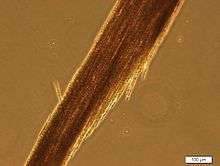Aphanizomenon
| Aphanizomenon | |
|---|---|
 | |
| Aphanizomenon flos-aquae | |
| Scientific classification | |
| Kingdom: | Bacteria |
| Phylum: | Cyanobacteria |
| Class: | see |
| Order: | Nostocales |
| Family: | Nostocaceae |
| Genus: | Aphanizomenon |
| Species | |
|
Aphanizomenon flos-aquae Aphanizomenon gracile Aphanizomenon issatschenkoi Aphanizomenon ovalisporum | |
Aphanizomenon is an important genus of cyanobacteria that inhabits freshwater lakes and can cause dense blooms. Studies on the species Aphanizomenon flos-aquae have shown that it can regulate buoyancy through light-induced changes in turgor pressure.[1] It is also able to move by means of gliding, though the specific mechanism by which this is possible is not yet known.
Ecology
Overcoming phosphate limitation
Aphanizomenon may become dominant in a water body partially due to their ability to induce phosphate-limitation in other phytoplankton while also increasing phosphate availability to itself through release of cylindrospermopsin.[2] The cylindrospermopsin causes other phytoplankton to increase their alkaline phosphatase activity, increasing inorganic phosphate availability in the water to Aphanizomenon during times when phosphate becomes limiting.
Nitrogen fixation
Aphanizomenon is capable of producing biologically-useful nitrogen (ammonium) by the process of nitrogen fixation from atmospheric nitrogen by use of specialized cells called heterocysts.
A large proportion (between 35-50%) of fixed nitrogen may be released into the surrounding water, providing an important source of biologically-available nitrogen to the ecosystem. [3][4]
Toxin production
Aphanizomenon species may produce cyanotoxins aside from cylindrospermopsin, including anatoxin-a, saxitoxin and BMAA.[5]
Colony formation

Aphanizomenon may form large colonies as a defense against herbivore grazing, especially Daphnia in freshwater. [6]
See also
References
- ↑ Konopka, A., T. D. Brock, and A. E. Walsby. 1978. "Buoyancy regulation by planktonic blue-green algae in Lake Mendota, Wisconsin." Arch. Hydrobiol. 83: 524-537.
- ↑ Yehonathan Bar-Yosef, Assaf Sukenik, Ora Hadas, Yehudit Viner-Mozzini and Aaron Kaplan (2010). "Enslavement in the Water Body by Toxic Aphanizomenon ovalisporum, Inducing Alkaline Phosphatase in Phytoplanktons". Current Biology. doi:10.1016/j.cub.2010.07.032.
- ↑ "N2-fixation, ammonium release and N-transfer to the microbial and classical food web within a plankton community". ISME Journal (Nature). 2015.
- ↑ "Carbon and nitrogen fluxes associated with the cyanobacterium Aphanizomenon sp. in the Baltic Sea". ISME Journal. 2010.
- ↑ "Cyanobacteria/Cyanotoxins". US EPA. 2015.
- ↑ "Aphanizomenon blooms: alternate control and cultivation by Daphnia pulex" (PDF). American Society of Limnology and Oceanography Special Symposium No. 3: 299-304. 1980.
Guiry, M.D.; Guiry, G.M. (2008). "Aphanizomenon". AlgaeBase. World-wide electronic publication, National University of Ireland, Galway.